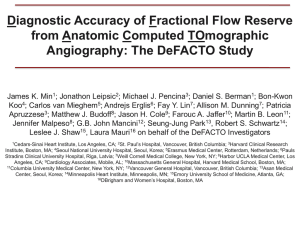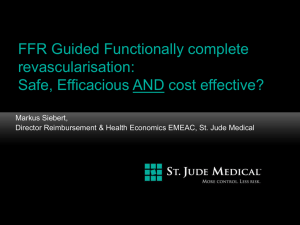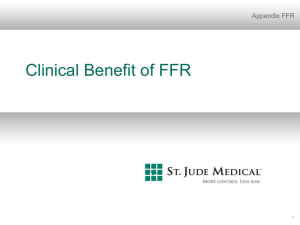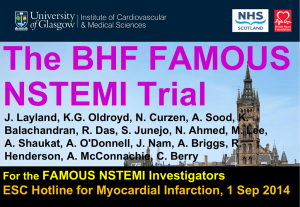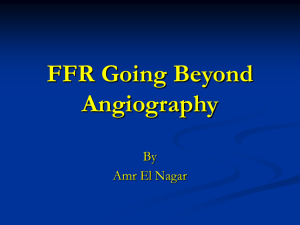To stent or not to stent
advertisement
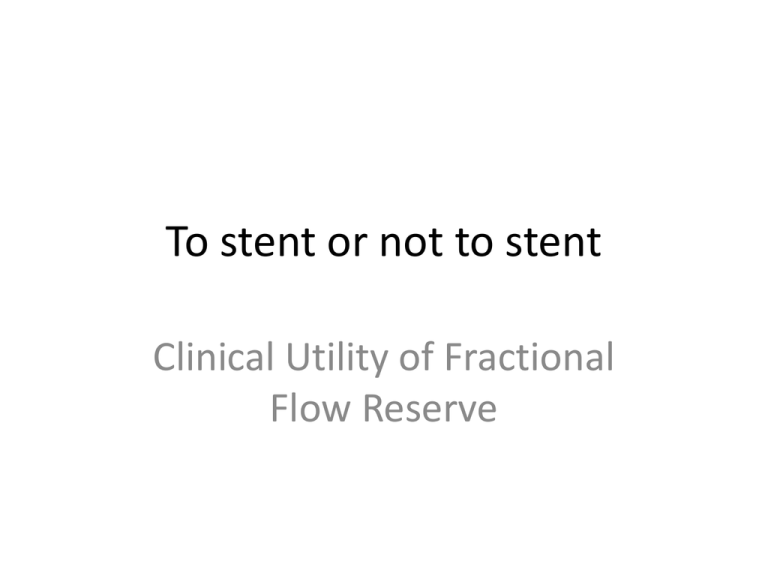
To stent or not to stent Clinical Utility of Fractional Flow Reserve Assessment of coronary artery stenosis • Inducible myocardial ischemia during functional testing has crucial prognostic significance in determining whether or not to treat coronary artery stenosis. • In real-world practice, however, fewer than half of all patients are evaluated noninvasively for myocardial ischemia before revascularization therapy. • Coronary angiograms are still frequently used as a cornerstone of decision making Assessment of coronary artery stenosis by angiogram • Luminogram • Purely anatomical • Inter and intra observer variability • Oculostenotic reflex Angiographic severity of stenosis • • • • Normal Minor disease Mild irreguralities Minimal disease • • • • Severe stenosis Super tight 99 percenter ! Die now ! if not treated Fractional flow reserve • Equivocal or intermediate lesions , and in the absence of demonstrated ischaemia, decision making based on angiography alone is challenging. • FFR has been extensively described and validated as a technique capable of identifying functionally significant lesions • FFR value below the threshold value of 0.75 corresponds to inducible ischaemia • Studies have shown that a strategy of revascularization based on FFR results in this context is acceptable. Coronary resistance • First compartment consists of large epicardial vessels which are also referred to as ‘conductance vessels’ • Minimal resistance to blood flow. • Therefore, the pressure in the distal part of a healthy coronary artery should be equal to central aortic pressure. • The second compartment consists of arteries smaller than 400 microns, or ‘resistive vessels’ • Myocardial flow is controlled predominantly by resistive vessels. Fractional flow reserve • FFR is the ratio of maximal myocardial blood flow in a stenotic artery to maximal myocardial blood flow if that same artery were to be normal • Normal value is 1 • FFR is a ratio of two flows • This ratio can be derived from two pressures (distal coronary pressure and aortic pressure), provided they are both measured during maximal hyperaemia. FFR = Pd/Pa Questions • What is the safety of using a coronary pressure wire for the measurement of FFR ? • Does the use of a coronary pressure wire for the measurement of FFR improve diagnostic accuracy? • Does the use of a coronary pressure wire for the measurement of FFR change patient management? • Does the use of a coronary pressure wire for the measurement of FFR improve patient outcome? • What is the cost-effectiveness of using a coronary pressure wire for the measurement of FFR ? Features of FFR • FFR has a theoretical normal value of 1 for every patient, for every artery and for every myocardial bed • FFR is not influenced by systemic haemodynamics • FFR takes into account the contribution of collaterals • FFR specifically relates the severity of the stenosis to the mass of tissue to be perfused Fractional flow reserve: clinical applications • Intermediate stenosis and deferring PCI/surgery • Multivessel disease and FFR directed PCI in multivessel disease. • • • • Left Main stem disease Bifurcation disease ; evaluation of side branch Post stenting After Myocardial Infarction • What is the safety of using a coronary pressure wire for the measurement of FFR • Does the use of a coronary pressure wire for the measurement of FFR improve diagnostic accuracy? • Does the use of a coronary pressure wire for the measurement of FFR change patient management? • Does the use of a coronary pressure wire for the measurement of FFR improve patient outcome? • What is the cost-effectiveness of using a coronary pressure wire for the measurement of FFR ? Is it safe ? • 6415 coronary angiographies, FFR was measured in 407 (6.3%) patients (469 lesions) • The only FFR related complication was an occlusive dissection due to a plaque dissection by the pressure wire. DEFER trial • Twenty six studies involving 2639 participants were identified that met the eligibility criteria for the safety component • Great majority of adverse effects reported were self limiting in nature Is it accurate ? Intermediate stenosis • Value of 0.75 has shown good corelation with non-invasive stress test, especially myocardial perfusion study • Sensitivity, specificity and accuracy 90% when compared to perfusion tests. Value of 0.75 NEJM 1996 Piljs et al • In 45 consecutive patients with moderate coronary stenosis and chest pain of uncertain origin, bicycle exercise testing, thallium scintigraphy, stress echocardiography with dobutamine, and quantitative coronary arteriography and compared the results with measurements of FFR • In all 21 patients with an FFR of less than 0.75, reversible myocardial ischemia was demonstrated unequivocally on at least one noninvasive test. • After coronary angioplasty or bypass surgery was performed, all the positive test results reverted to normal • Sensitivity of FFR in the identification of reversible ischemia was 88 percent, the specificity 100 percent, the positive predictive value 100 percent, the negative predictive value 88 percent, and the accuracy 93 percent. Does it alter patient management 4-year single-centre experience Angiogram for any reason Intermediate lesions 40% - 60% on QCA 6415 coronary angiographies, FFR was measured in 407 (6.3%) patients (469 lesions) 2/3rds of patients with ‘intermediate’ lesions were left unrevascularized, with a favourable outcome, when FFR was above 0.80. DEFER Trial DEFER DEFER Does routine use improve patient outcome FFR directed PCI in multivessel disease : FAME trial FAME EVENTS AT 2 YEARS Is it cost effective ? Am Heart J. 2003 May;145(5):882-7. Cost-effectiveness of measuring fractional flow reserve to guide coronary interventions • • • • • • Decision model to compare the long-term costs and benefits of 3 strategies for treating patients with an intermediate coronary lesion and no prior functional study: 1) deferring the decision for percutaneous coronary intervention (PCI) to obtain a nuclear stress imaging study (NUC strategy) 2) measuring fractional flow reserve (FFR) at the time of angiography to help guide the decision for PCI (FFR strategy); 3) stenting all intermediate lesions (STENT strategy). Estimated the cost of FFR to be 761 dollars, the cost of nuclear stress imaging to be 1093 dollars, and the cost of medical treatment for angina to be 1775 dollars per year. The extra cost of splitting the angiogram and PCI as dictated by the NUC strategy was 3886 dollars by use of hospital cost-accounting data. The FFR strategy saved 1795 dollars per patient compared with the NUC strategy and 3830 dollars compared with the STENT strategy. Compared with the FFR strategy, the NUC strategy was expensive Both screening strategies were superior to (less cost, better outcomes) the STENT strategy. In patients with an intermediate coronary lesion and no prior functional study, measuring FFR to guide the decision to perform PCI may lead to significant cost savings compared with performing nuclear stress imaging or with simply stenting lesions in all patients. All in one approach for suspected CAD ? • What is the safety of using a coronary pressure wire for the measurement of FFR ? • Does the use of a coronary pressure wire for the measurement of FFR improve diagnostic accuracy? • Does the use of a coronary pressure wire for the measurement of FFR change patient management? • Does the use of a coronary pressure wire for the measurement of FFR improve patient outcome? • What is the cost-effectiveness of using a coronary pressure wire for the measurement of FFR ? • AHA/ACC guidelines are IIa for FFR ( level of evidence A), and European PCI guidelines have recommendation I (level of evidence A) for FFR without objective evidence of ischemia. • Although the use of FFR measurement has increased steadily over the past decade, FFR is not frequently used in the cath lab. • Multiple factors, including habit, bias, training experience,, financial incentives, misconceptions by patients, a perception by referring physicians of the need to stent coronary stenosis, cumbersome set-up time, and reimbursement for pressure wires.
